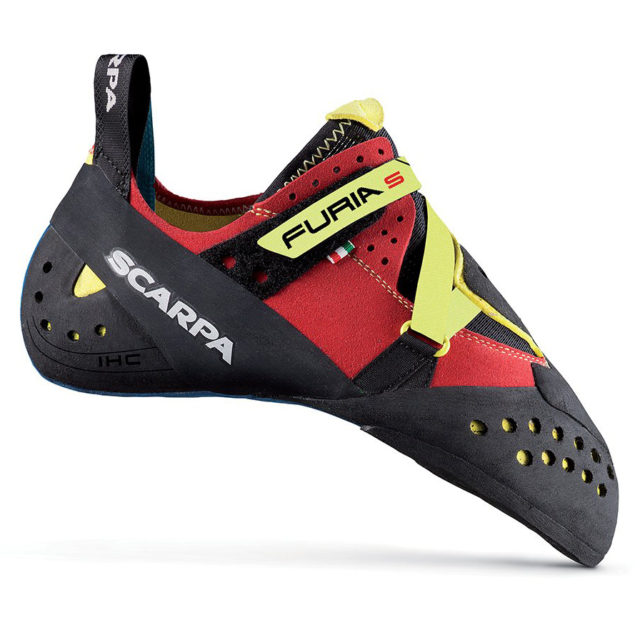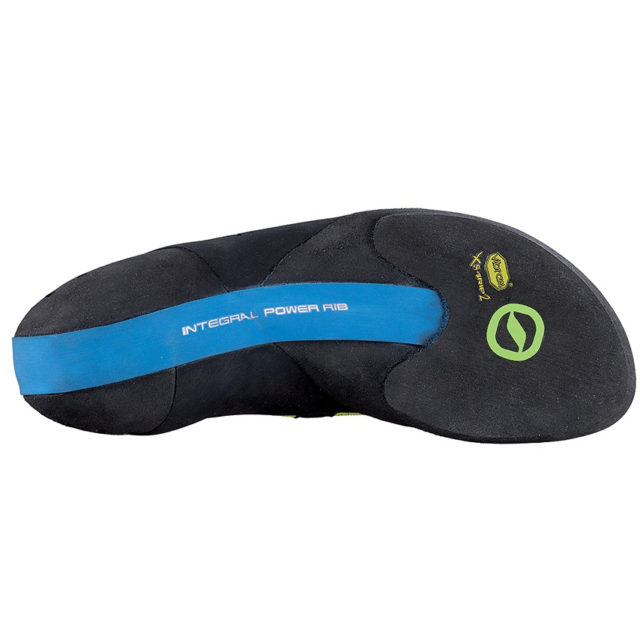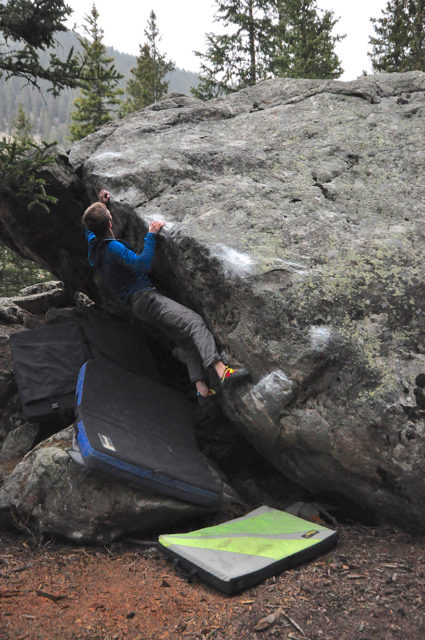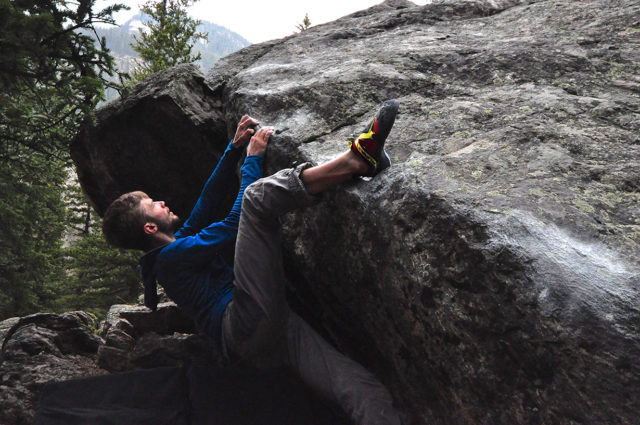
Scarpa Furia S
Available Sizes: EU Men’s 35- 45
Reviewer Street Shoe Size: 10-10.5 (EU 41-42)
Size Tested: EU Men’s 41.5
Construction
- Upper: Microfiber
- Midsole: 1.0 mm Flexan
- Outsole: Vibram XS Grip2, 3.5 mm
- Closure: Velcro, Wave closure system
MSRP: $TBA (Currently available in Europe for €130)
Test Locations: Guanella Pass, Flagstaff Mountain, & Chaos Canyon, CO
Days Tested: ~10 days of outdoor bouldering; ~20 days of indoor gym use
Intro
Over the past few years we’ve seen a trend of climbing shoe companies making their aggressive, high-performance shoes softer and softer. The idea is that, with a softer shoe, you get more precision, better grip on tiny footholds, and a more sensitive overall feel.
The Scarpa Furia S is one of the most recent additions to this category, and is a new version of Scarpa’s original Furia. The original Furia was the softest shoe in Scarpa’s line, designed to excel on overhung routes and boulder problems. And while I know many climbers who loved it, the Furia never seemed to reach the same popularity as some of Scarpa’s other models.
The new Furia S aims to change that.
The Furia S could be viewed as a fusion of the Scarpa Drago and the original Furia. The Furia S has much more toe rubber coverage than the original Furia, and it’s intended to fit a larger range of foot shapes than both the Furia and Drago because of the Furia S’ new “Wave” closure system.
The Furia S maintains the original Furia’s extremely soft feel and downturned shape, putting it in the same category as shoes like the Five Ten Team VXI and La Sportiva Futura.
My narrower feet were never really able to fill out the front of the Drago, so the potentially tighter closure system of the Furia S caught my attention. And after about 30 days in the shoe, I’ve come to really like the Furia S, and I think it offers a unique climbing experience for those looking for an ultra-sensitive, aggressive shoe for bouldering and hard sport routes.
What Scarpa says about the Furia S:
“Ultra soft and sensitive, the Furia S gives the climber a barefoot-like experience with excellent prehensile grabbing ability. The asymmetrical and downturned shape with a medium-to-high angled toe box provides maximum toe sensitivity. The Multi-panel upper has a seamless big toe panel and offset fourth toe stitch for the best custom moulding fit and comfort and the high stretch gusset allows easy entry while the IPR system helps reduce excess material and increase the overall sensitivity, precision and adaptability of the shoes. The Wave shape strap closure system spreads the pressure evenly across the upper from the strap and buckles. It gives a glove-like fit with excellent flexibility for the foot during bouldering or climbing.”
There’s a lot going on in this description, but the primary notes revolve around the Furia S’ sensitivity, flexibility, and glove-like fit. So are those claims accurate?
Last and Geometry
Similar to the Drago and original Furia, the Furia S has a highly asymmetrical shape that twists the foot inward toward the big toe. This shape is especially helpful for a soft shoe like the Furia S.
Stiff shoes are often much better than soft shoes when it comes to powering off of holds, since a stiffer outsole and midsole transfer power better through the big toe. Soft shoes suffer in this regard because power is lost when the shoe flexes (instead, the climber’s foot must provide the support in softer shoes).
While the asymmetrical shape of a shoe like the Furia S isn’t the perfect solution to this problem, it does seem to help when it comes to power transfer through the foot. I have found that the Furia S definitely inspires more confidence when making big moves off small footholds compared to similarly soft shoes like the Five Ten Team VXI. The Furia S is very downturned, which also helps counteract its soft construction when pushing off of small footholds on steeper climbs.

The shape and soft rubber of the Furia S allow me to wrap my toe around holds, which is especially useful on overhung routes. The Furia S’ soft construction also allows the shoe to flatten out when standing on it, which makes the shoe work really well on slabbier footholds where the shoe is able to mold around the rock features, helping me keep my foot in place. But the Furia S is definitely not the best shoe for sustained, vertical or less-than-vertical edging (see the Performance section further down).
The toe box of the Furia S does seem to be slightly lower-volume than the Drago, though the two shoes reportedly share the same last. But for my feet at least, I was able to get a more precise fit in the Furia S, which is probably in part due to the Furia S’ new closure system (more on that below).
The Furia S’ IPR Tension System (the blue stripe on the underside of the shoe) is pretty amazing and I’d say it’s best described as “fun.” The IPR band is used to maintain the shape and tension of the Furia S since it’s so soft, and I think it achieves this and more. The IPR band adds a feeling of “spring” to the shoe, making the Furia S feel energetic and agile while climbing. The built up tension and soft rubber of the Furia S made me slightly change my overall climbing style from slower, more static movements to faster and more coordinated ones.

Size & Fit
As always, we recommend trying on shoes yourself to see how they’ll work with your feet. But with that said, I’ll talk about my own experience with the Furia S.
When I first tried on the Furia S (in my usual street shoe size of 41.5), I was actually very dismayed. The shoe seemed to have a massive air pocket beneath the arch of my foot and heel, though the toe box fit okay after tightening the closure system. However (and I think this could be the case for many individuals), the Furia S’ rubber is so soft that after consistent climbing for about 5 minutes, the shoes heated up a bit and molded almost perfectly to my foot. This process still happens every time I climb in them, creating a nice, snug fit.
I found the Furia S to be very comfortable, especially for such a downturned shoe. I was able to complete “euro style” coordination problems involving stepping quickly on volumes, as well as longer climbing days without feeling any pain in the Furia S. Additionally, the Furia S’ break-in period was almost non-existent for me — the Furia S features a microfiber upper that doesn’t stretch over time as much as most leather uppers.
Many climbers (myself included) dramatically downsize their aggressive climbing shoes. But with the Furia S I think you have to be extra careful not to downsize too much. If the Furia S is really tight on your foot, the outside rand can actually roll over the sole of the shoe since it’s so soft. Given this, I recommend either going a half-size up with the Furia S, or going with the larger size if you’re torn trying to decide between two sizes. And just to reiterate, your feet and experience may differ, so I’d first and foremost recommend that you try on the Furia S to see how it works with your feet.
Vibram XS Grip2 Rubber & Construction
The Vibram XS Grip2 rubber used on the Furia S is used on a lot of aggressive climbing shoes, and for good reason — it’s very sticky and malleable. The Furia S’ 3.5 mm outsole is similar in thickness to those on other similarly soft shoes like the Five Ten Team VXI, Scarpa Drago, and La Sportiva Python.
The Furia S’ thinner outsole, combined with its 1.0 mm flexan midsole, makes it one of the softest shoes I’ve ever worn. Despite how soft it is, the Furia S’s rubber has proven to be reasonably durable (unlike the 5.10 Team VXI, which uses a 3.5 mm Stealth Mi6 outsole that wore down quicker than the Furia S’ outsole).

The Furia S’ rubber is holding up well after around 30 total days of climbing, some of which was on rough granite. Unfortunately the durability of the Furia S’ sole doesn’t extend as well to the rubber on top of the shoe’s toe box. Because the Furia S uses thin, climbing-grade rubber on the top of the shoe, it’s incredibly sticky and useful for toe hooks. But the downside to this is that the rubber on the Furia S’ upper toe box has worn quicker than other areas of the shoe where the rubber is thicker.
The inner lining and soft, conforming feel of the Furia S made it comfortable and easy to slip on. The construction and overall quality of this shoe feels top-notch.
The Furia S’ Wave closure system is one of my favorite features on the shoe. I was able to tighten the whole shoe with even pressure across my foot, and I think this closure system makes the Furia S more versatile in terms of fitting various foot types.
The Scarpa Drago is a bit too wide in the forefoot for my feet, but with the closure system on the Furia S, I was able to tighten the shoe to get a nice, precise fit (despite both shoes sharing the same last). At first, I was a bit worried about the durability of the Furia S’ closure system because the strap and velcro patch are so thin, but I haven’t had any problems with either the strap or velcro coming loose or wearing down during my time in the Furia S.
Performance / Who’s It For?
The Furia S is an amazing shoe for overhung bouldering or competition climbing. Its rubber is sticky and soft, allowing the shoe to grab and mold around terribly slippery feet.
For example, there are a series of moves on Dark Horse (V10) up at Guanella Pass that revolve around some slippery, slopey feet in a roof. I’ve had trouble with these moves before, but in the Furia S I felt much more confident and was able to really pull into the slippery holds with my toes.
The Furia S’ springy IPR tension band had me jumping all over the wall, with a grin on my face the whole time. I think the Furia S would be an exceptional competition shoe, especially for routes involving precise footwork and / or dynamic movements. That being said, this shoe is definitely not for everyone.

I would not suggest the Furia S for vertical or less-than-vertical edging — when I tried to do this in the Furia S my feet were sore for a couple days. The Furia S could potentially work in this arena for climbers with incredibly well-developed foot muscles, but there are much better choices for vertical terrain. Some options for this include the La Sportiva Miura, the Scarpa Vapor V or Instinct VS, and the Evolv Oracle.
Much like the La Sportiva Futura, the Furia S doesn’t really edge on any foot chip or hold. Instead, it smears around the hold (“Smedging?”), providing much better friction and not requiring the climber to have pinpoint accuracy when it comes to foot placement. But the Furia S’ soft flex also means that it does not offer the support of stiffer shoes, which can lead to foot fatigue after sustained vertical edging. This is especially noticeable when transitioning from stiffer shoes and first getting accustomed to the Furia S’ soft flex.
I’d say the Furia S is an excellent overhung bouldering or competition specialist. I think it’s best suited for advanced climbers who want to get maximum performance on steep moves requiring whole-body tension on tenuous feet. The Furia S’ grip, sensitivity, and durability (compared to other similarly soft shoes like the Team XVI) makes it a very strong contender in this class.
Comparisons
It’s hard to ignore the similarities between the Furia S and the Scarpa Drago. Both shoes are built on the same last with the same 3.5 mm Vibram XS Grip2 outsole. The differences between the two shoes are subtle, but present. The Drago’s rand is thicker, as is the rubber around its heel. The Furia S has less rubber on the rand around the arch of the foot, allowing for more flexibility compared to the Drago. The Fura S’ heel is also thinner, without any rubber-cup covering.
In combination with the Furia S’ new IPR Tensioning band, the qualities mentioned above make the Furia S feel a bit softer and more “glovelike” compared to the Drago. Although the Drago is probably a bit more versatile than the Furia S, if you’re looking for a soft, specialist shoe for difficult, overhung climbing, I’d go with the Furia S. I also think that the Furia S’ strap system should help it fit a broader range of foot shapes, as I was able to get a snug fit in the Furia S but not the Drago, despite the two shoes being built on the same last.
The Five Ten Team VXI is another shoe that’s comparable to the Furia S. The Team VXI might actually be a bit softer than the Furia S, but it has comparatively horrible durability when it comes to the Team VXI’s rubber. The Team VXI also didn’t feel as confidence-inspiring when powering off of small holds compared to the Furia S.
The La Sportiva Futura is another shoe that, to me, feels like it climbs similarly to the Furia S. The Futura doesn’t feel quite as precise and malleable on overhung holds (largely because of the Futura’s stiffer midsole and its “no-edge” technology). Both the Furia S and Futura aim to allow for faster movement on the wall, but the Furia S’ IPR tension band really puts it ahead of the competition when it comes to moving quickly and dynamically. The IPR band pulls down the front of the foot, creating a sort of spring-like sensation when pressing down on a foothold. This allowed more power generation off my feet than I would usually associate with a shoe as soft as the Furia S.
Bottom Line
The Scarpa Furia S performs exceptionally well on overhung boulders or routes, as well as in competition settings. The Furia S’ malleable and sensitive sole make it a great option for advanced climbers looking for a shoe that will give them a confidence boost on slippery or tensiony feet. The Furia S does require stronger toes / foot muscles than stiffer shoes do, and therefore isn’t a great choice for beginners. I also wouldn’t recommend the Furia S for technical face climbing, since there are plenty of better (and mostly stiffer) options out there. But if you’re looking for a shoe for technical, overhung climbs, the Furia S just might be the shoe that enables you to climb faster, more confidently, and with more fun.

Great review. Though, I would like to emphasize that the lack of “rubbercup covering” over the heel is a deal breaker. When I first saw this shoe’s exposed Internal Power Rib (IPR) rand down the middle of the heel I couldn’t believe it. Especially, since I’ve seen photos on the web of an earlier iteration where Scarpa original placed XS Grip 2 over this IPR. Just like Scarpa does on EVERY other high end shoe in their line up. Embarrassingly, I drank the cool-aid of the new design, hoping the heel was in fact all sticky rubber. Unfortunately, this is not the case. I have since spoken with a Scarpa rep to ask if the exposed IPR was sticky rubber and his response was, no. My take on the conversation was the rep was embarrassed. In the end, he suggested the Drago. In practice, when placing a crucial heel, one that would pull off your slippers of yesteryear, this shoe will unexpectedly blast off. These are obviously just opinions, but I simply can not recommend this shoe due to the inexplicable heel design.
Good review, but if your advice to “size-up” is based on your conversion of US size 10 – 10.5 to euro 42-43, I think that’s a mistake.
If your US shoe size is 10-10.5 then your euro size is 43.5 to 44. So if you are wearing the Furia in size 41.5 you are sizing down 2 full sizes!
The scarpa shoes size conversion is here, and most other companies have a very similar conversion
https://weighmyrack.com/sites/default/files//legacy_files/shoe_size_charts/Scarpa-Shoe-Size-Chart.pdf